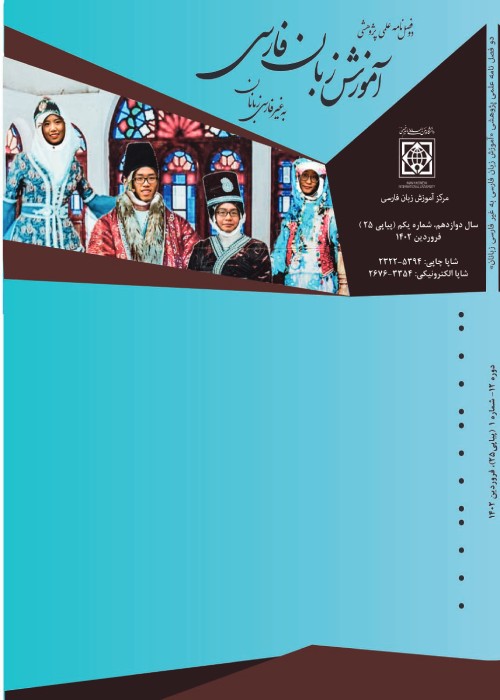Studying the Effect of Gender on Azeri-Speaking Students' Attitudes toward Persian Language in Marand
The present study examined the effect of gender on Azeri-speaking students’ attitudes toward Persian language in Marand, East Azerbaijan, Iran. Attitude is a set of beliefs that learners have about the members of the target language community as well as about their culture. The statistical population in this study included 400 high school students in Marand during the academic year of 2014-2015. Simple random sampling method was used. In the present study, data were collected using a two-part questionnaire. To ensure the reliability of the questionnaire, among common methods for data collection, adaptation and modification of existing methods were used. To test the research hypothesis, inferential statistics including independent samples t-tests were used. In the present article, it was revealed that there is a significant difference between the two groups in attitudes toward using Persian language. Female students had more positive attitudes towards the subject compared to boys. Regarding the effect of the attitudes of the two gender groups on the use of Persian language, it was concluded that girls’ positive attitudes makes them use Persian in most situations; while male students, prefer to use their mother tongue, i.e. Azeri Turkish, in similar situations.Persian language is widely used by all Iranians within the multilingual Iran. It should be noted that Persian is utilized by some speakers as their mother tongue and by some others as their second language. Being the sole official language and the language of instruction in Iran, Persian is used for all the official and educational purposes in the country. However, at least on the basis of our observations in our study area, Persian is not the only language used for instructional goals at bilingual schools in the country. It is observed that non-Persian-speaking students in bilingual areas including East Azerbaijan province tend to make use of their mother tongue besides Persian for their educational goals. Regarding Persian language use, bilingual students seem to show different behaviors. Some prefer to speak Persian in almost all settings including school, particularly with their teachers while some others show little or even no inclination to use Persian. Such reactions to using the second language are rooted in various factors such as attitudes, motivations, anxiety, and gender.Among the leading factors affecting second language use, attitude and gender have been surveyed in this research. Specifically speaking, the present paper has strived to study the Azeri-speaking students’ gender-based attitudes toward using Persian language. Brown (1981) states that attitudes are a set of beliefs that learners have about the members of the target language community (for example, whether they are honest, boring, interesting or not) and also about their culture. Fossold (1986: 93) holds that attitude is mainly based on a subjectivist view, and that attitude consists of three elements of cognition, emotion, and practice.In the present study, data were collected using a two-part questionnaire. To ensure the reliability of the questionnaire, among the common methods for data collection, adaptation and modification of existing methods was used. To this end, the attitude statements in the questionnaire in Hakuta and Dandrea (1992) and the Berni (1998) were first translated into Persian and then modified according to the purpose of the present research. The questionnaire included in the dissertation (SotoudehNama, 2001) was also used to make changes. The questionnaire used in this article consisted of two parts: background questions for gender, place of study, age, educational background sentences, including 39 items on a five-point Likert scale to measure subjects' attitudes toward using the Persian language. The expressions in the questionnaire itself consisted of three parts. The first part consisted of 13 phrases that assessed the students' perception of using the Persian language. The second part, with 13 phrases, assessed the behavior (choice between Persian and Turkish languages) of the subjects regarding the use of Persian language. The last 13 sentences measured the subjects' perception of their use of the Persian language. Subjects chose one of the five options “strongly agree, agree, I have no idea, disagree, and strongly disagree”. The overall score was calculated for each subject, i.e., sum of the scores given that, wherever the answer was in agreement with the subject, a score of 5 would be given for completely agreed, and in cases where it was against the attitude, the score of 5 would be given to I totally disagreed, and I totally agree with Score 1. In order to present the questionnaires to the students, researchers went to all schools in person. Before completing the questionnaires, the students were briefed on the research objectives and how to complete the questionnaire. Subjects were given adequate time to answer questions. All 400 questionnaires were completed by 400 subjects and then were collected and analyzed by gender of the subjects for data analysis. SPSS software was used for data analysis and calculation accuracy. First, descriptive statistics including tables and statistical indices were given, then in the second part, in order to test the research hypotheses, inferential statistics including independent samples t-tests were used for both genders. Also, chi-square test was used to assess the effect of the attitude of two groups on using Persian language in different situations.In the present article, it was revealed that there is a significant difference between the two groups in attitudes toward using Persian language. Female students had a positive attitude towards the subject compared to boys. Regarding the effect of the attitude of the two gender groups on the use of Persian language, it was concluded that girls’ positive attitudes makes them use Persian in most situations; while male students prefer to use their mother tongue, i.e. Azeri Turkish, in similar situations.
- حق عضویت دریافتی صرف حمایت از نشریات عضو و نگهداری، تکمیل و توسعه مگیران میشود.
- پرداخت حق اشتراک و دانلود مقالات اجازه بازنشر آن در سایر رسانههای چاپی و دیجیتال را به کاربر نمیدهد.




